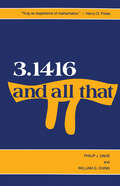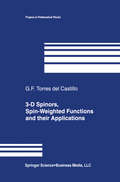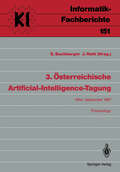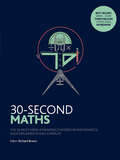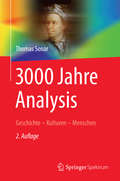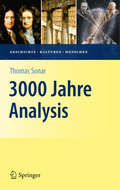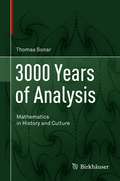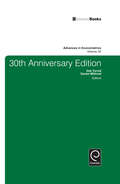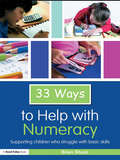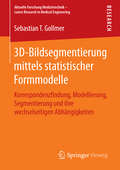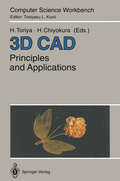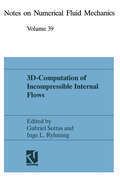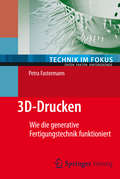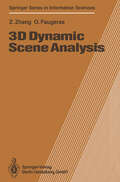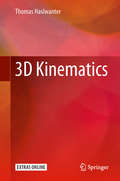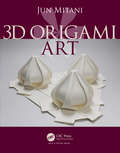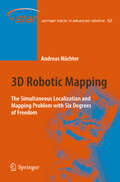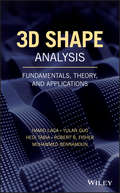- Table View
- List View
3.1416 And All That
by DAVIS CHINNLYTTON STRACHEY tells the following story. In intervals of relaxation from his art, the painter Degas used to try his hand at writing sonnets. One day, while so engaged, he found that his in spiration had run dry. In desperation he ran to his friend Mallarme, who was a poet. "My poem won't come out," he said, "and yet I'm full of excellent ideas. " "My dear Degas," Mallarme retorted, "poetry is not written with ideas, it is written with words. " If we seek an application of Mallarme's words to mathematics we find that we shall want to turn his paradox around. We are led to say that mathematics does not consist of formulas, it consists of ideas. What is platitudinous about this statement is that mathe matics, of course, consists of ideas. Who but the most unregenerate formalist, asserting that mathematics is a meaningless game played with symbols, would deny it? What is paradoxical about the state ment is that symbols and formulas dominate the mathematical page, and so one is naturally led to equate mathematics with its formulas.
3-D Spinors, Spin-Weighted Functions and their Applications (Progress in Mathematical Physics #32)
by Gerardo F. Torres del CastilloThis book on the theory of three-dimensional spinors and their applications fills an important gap in the literature. It gives an introductory treatment of spinors. From the reviews: "Gathers much of what can be done with 3-D spinors in an easy-to-read, self-contained form designed for applications that will supplement many available spinor treatments. The book…should be appealing to graduate students and researchers in relativity and mathematical physics." -—MATHEMATICAL REVIEWS
3. Österreichische Artificial-Intelligence-Tagung: Wien, 22–25. September 1987 (Informatik-Fachberichte #151)
by Ernst Buchberger Johannes Retti30-Second Maths: The 50 Most Mind-expanding Theories In Mathematics, Each Explained In Half A Minute (30-second Ser.)
by Richard BrownFrom Rubik's cubes to Godel's incompleteness theorem, everything mathematical explained, with colour illustrations, in half a minute. Maths is enjoying a resurgence in popularity. So how can you avoid being the only dinner guest who has no idea who Fermat was, or what he proved? The more you know about Maths, the less of a science it becomes. 30 Second Maths takes the top 50 most engaging mathematical theories, and explains them to the general reader in half a minute, using nothing more than two pages, 200 words and one picture. Read at your own pace, and discover that maths can be more fascinating than you ever imagined.
30 Years of Change for Children (PDF)
by Gillian PughHow well have children fared in the UK in the thirty years since the National Children's Bureau was established in 1963. How has family life changed? What have been the main social and demographic changes? Has the welfare state continued to provide education, health care and social welfare for all children? These and other questions are considered as the authors reflect on the main changes in legislation, on key messages from research and on whether developments in practice have reflected these research findings.
3000 Jahre Analysis: Geschichte - Kulturen - Menschen (Vom Zählstein zum Computer)
by Thomas SonarIn dem Band werden Entstehung und Entwicklung der grundlegenden Begriffe der Analysis von der Antike bis heute ausführlich behandelt. Eingebettet sind diese Informationen in die Beschreibung historischer und kultureller Ereignisse, die Lebensläufe bedeutender Mathematiker und der von ihnen entwickelten Teilgebiete der Analysis. Zahlreiche gezeichnete Figuren veranschaulichen Begriffe, Lehrsätze und Methoden. Jedes Kapitel enthält eine Tabelle mit den Daten der wesentlichen Ergebnisse und Ereignisse aus 3000 Jahren Analysis.
3000 Jahre Analysis: Geschichte, Kulturen, Menschen (Vom Zählstein zum Computer)
by Thomas SonarIn dem Band werden Entstehung und Entwicklung der grundlegenden Begriffe der Analysis von der Antike bis heute ausführlich behandelt. Eingebettet sind diese Informationen in die Beschreibung historischer und kultureller Ereignisse, die Lebensläufe bedeutender Mathematiker und der von ihnen entwickelten Teilgebiete der Analysis. Zahlreiche gezeichnete Figuren veranschaulichen Begriffe, Lehrsätze und Methoden. Jedes Kapitel enthält eine Tabelle mit den Daten der wesentlichen Ergebnisse und Ereignisse aus 3000 Jahren Analysis.
3000 Years of Analysis: Mathematics in History and Culture
by Thomas SonarWhat exactly is analysis? What are infinitely small or infinitely large quantities? What are indivisibles and infinitesimals? What are real numbers, continuity, the continuum, differentials, and integrals?You’ll find the answers to these and other questions in this unique book! It explains in detail the origins and evolution of this important branch of mathematics, which Euler dubbed the “analysis of the infinite.” A wealth of diagrams, tables, color images and figures serve to illustrate the fascinating history of analysis from Antiquity to the present. Further, the content is presented in connection with the historical and cultural events of the respective epochs, the lives of the scholars seeking knowledge, and insights into the subfields of analysis they created and shaped, as well as the applications in virtually every aspect of modern life that were made possible by analysis.
30th Anniversary Edition (Advances in Econometrics #30)
by Dek Terrell Daniel Millimet Carter Hill Tom FombyThe 30th Volume of Advances in Econometrics is in honor of the two individuals whose hard work has helped ensure thirty successful years of the series, Thomas Fomby and R. Carter Hill. This volume began with a history of the Advances series by Asli Ogunc and Randall Campbell summarizing the prior volumes. Tom Fomby and Carter Hill both provide discussions of the role of Advances over the years. The remaining articles include contributions by a number of authors who have played key roles in the series over the years and in the careers of Fomby and Hill. Overall, this leads to a more diverse mix of papers than a typical volume of Advances in Econometrics.
33 Ways to Help with Numeracy: Supporting Children who Struggle with Basic Skills (Thirty Three Ways to Help with....)
by Brian SharpThirty Three Ways to Help with Numeracy equips teachers and teaching assistants with a wide range of practical resources to help children who are having difficulties learning the basic skills of numeracy. By providing a range of activities and games which engage children and encourage motivation in the classroom, the book provides ready-to-use exercises that don’t need lengthy forward preparation. Any materials needed are readily available in the classroom or are provided here to photocopy. The activities are designed using a range of different learning styles to: build learners’ confidence and self esteem develop reasoning and thinking about physical number situations encourage discussions explore numbers by doing The activities can be used with individual children, groups or the whole class. The introduction at the head of each activity describes precisely what it aims to teach the child, followed by clear, concise instructions on how to play each game. Teachers, SENCos and Teaching Assistants will welcome this helpful resource, which complements Thirty Three Ways to Help with Reading also available from Routledge.
33 Ways to Help with Numeracy: Supporting Children who Struggle with Basic Skills (Thirty Three Ways to Help with....)
by Brian SharpThirty Three Ways to Help with Numeracy equips teachers and teaching assistants with a wide range of practical resources to help children who are having difficulties learning the basic skills of numeracy. By providing a range of activities and games which engage children and encourage motivation in the classroom, the book provides ready-to-use exercises that don’t need lengthy forward preparation. Any materials needed are readily available in the classroom or are provided here to photocopy. The activities are designed using a range of different learning styles to: build learners’ confidence and self esteem develop reasoning and thinking about physical number situations encourage discussions explore numbers by doing The activities can be used with individual children, groups or the whole class. The introduction at the head of each activity describes precisely what it aims to teach the child, followed by clear, concise instructions on how to play each game. Teachers, SENCos and Teaching Assistants will welcome this helpful resource, which complements Thirty Three Ways to Help with Reading also available from Routledge.
3D-Bildsegmentierung mittels statistischer Formmodelle: Korrespondenzfindung, Modellierung, Segmentierung und ihre wechselseitigen Abhängigkeiten (Aktuelle Forschung Medizintechnik – Latest Research in Medical Engineering)
by Sebastian T. GollmerSebastian T. Gollmer entwickelt neue Methoden und Algorithmen für die Erstellung statistischer Formmodelle, die Formmodellierung und die formmodellbasierte Bildsegmentierung. Der Autor diskutiert ihre Vorteile gegenüber den jeweils etablierten Verfahren aus der Literatur und evaluiert den generellen Einfluss dieser drei Aspekte auf die erzielbare Segmentierungsgenauigkeit. Letzteres erfolgt sowohl unter Verwendung neu entwickelter und etablierter Evaluierungsverfahren als auch im Rahmen realer Anwendungen. Von besonderer praktischer Relevanz zeigen sich dabei die exzellenten, mit einem neuen vollautomatischen Algorithmus erzielten Ergebnisse für die Unterkiefersegmentierung.
3D CAD: Principles and Applications (Computer Science Workbench)
by Hiroshi Toriya H. Yaguchi Hiroaki Chiyokura3D CAD is one of the most important technologies of the 90s for the engineering and manufacturing world. 3D CAD systems can provide a competitive edge in the development of new products. This book presents the development of a three-dimensional CAD system and its wide range of applications. It describes the concepts of solid models, and the theory of curves and surfaces and it illustrates these concepts through "reals world" applications.
3D-Computation of Incompressible Internal Flows: Proceedings of the GAMM Workshop held at EPFL, 13–15 September 1989, Lausanne, Switzerland (Notes on Numerical Fluid Mechanics and Multidisciplinary Design #39)
by Gabriel Sottas Inge L. RyhmingThe aim of the 1989 GAMM Workshop on 3D-Computation of Incompressible Internal Flows was the simulation of a realistic incompressible flow field in an important industrial application. In view of the difficulties involved in formulating such a test case, requiring the availability of an experimental data base, extreme care had to be taken in the selection of the proper one. Professor I. L. Ryhming's proposal, that the flow through a Francis turbine configuration or parts thereof would be feasible as a test case, because of the numerical challenges as well as the possibility to produce an experimental data base by using the experimental facilities of the Hydraulic Machines and Fluid Mechanics Institute (IMHEF) at the Swiss Federal Institute of Technology in Lausanne (EPFL), was accepted by the GAMM Committee in April 1987. A scientific committee, formed under the chairmanship of Professor I. L. Ryhming, met a few times to decide on the Francis turbine configuration, the test case specifications, etc. , whereby the design input came from the water turbine experts. This committee decided to restrict the studies to the three following typical applications for the best operating point of the turbine: • simulation of the 3D flow in a Francis runner in rotation • simulation of the 3D flow in the distributor (stay and guide vane rings) of this turbine • simulation of the 3D flow in an elbow draft tube The simultaneous computation of two or three of these geometries was encouraged.
3D-Drucken: Wie die generative Fertigungstechnik funktioniert (Technik im Fokus)
by Petra FastermannWie funktioniert 3D-Druck? Wofür eignet sich welche 3D-Druck-Technologie? Was bedeutet 3D-Druck für den Einzelnen? Welche gesellschaftlichen und wirtschaftlichen Veränderungen wird es durch diese Zukunftstechnologie geben? Die Autorin gibt Antworten auf diese Fragen. Sie führt präzise und einfach in die immer populärer werdende Technologie des 3D-Drucks ein. Die Leser werden so in den Stand versetzt, 3D-Druck selbst anzuwenden. Sie lernen, kostenlose Software auszuprobieren oder vielleicht sogar in einer der immer zahlreicher werdenden offenen Werkstätten (FabLabs) einen 3D-Drucker selbst zu nutzen.
3D Dynamic Scene Analysis: A Stereo Based Approach (Springer Series in Information Sciences #27)
by Zhengyou Zhang Olivier Faugerashe problem of analyzing sequences of images to extract three-dimensional T motion and structure has been at the heart of the research in computer vi sion for many years. It is very important since its success or failure will determine whether or not vision can be used as a sensory process in reactive systems. The considerable research interest in this field has been motivated at least by the following two points: 1. The redundancy of information contained in time-varying images can over come several difficulties encountered in interpreting a single image. 2. There are a lot of important applications including automatic vehicle driv ing, traffic control, aerial surveillance, medical inspection and global model construction. However, there are many new problems which should be solved: how to effi ciently process the abundant information contained in time-varying images, how to model the change between images, how to model the uncertainty inherently associated with the imaging system and how to solve inverse problems which are generally ill-posed. There are of course many possibilities for attacking these problems and many more remain to be explored. We discuss a few of them in this book based on work carried out during the last five years in the Computer Vision and Robotics Group at INRIA (Institut National de Recherche en Informatique et en Automatique).
3D Kinematics
by Thomas HaslwanterThis book presents an introduction to the analysis of general movements in 3D space, especially for movements of the human body. It is based on the lecture notes of a class on 3D Kinematics, which the author has been holding in the Master Degree Program of his home institution, the University of Applied Sciences Upper Austria. The lecture introduces the mathematics underlying the measurement and analysis of 3D movements. The target audience primarily comprises research experts in the field, but the book may also be beneficial for graduate students alike.
3D Origami Art
by Jun MitaniEasily Create Origami with Curved Folds and Surfaces Origami—making shapes only through folding—reveals a fascinating area of geometry woven with a variety of representations. The world of origami has progressed dramatically since the advent of computer programs to perform the necessary computations for origami design. 3D Origami Art presents the design methods underlying 3D creations derived from computation. It includes numerous photos and design drawings called crease patterns, which are available for download on the author’s website. Through the book’s clear figures and descriptions, readers can easily create geometric 3D structures out of a set of lines and curves drawn on a 2D plane. The author uses various shapes of sheets such as rectangles and regular polygons, instead of square paper, to create the origami. Many of the origami creations have a 3D structure composed of curved surfaces, and some of them have complicated forms. However, the background theory underlying all the creations is very simple. The author shows how different origami forms are designed from a common theory.
3D Origami Art
by Jun MitaniEasily Create Origami with Curved Folds and Surfaces Origami—making shapes only through folding—reveals a fascinating area of geometry woven with a variety of representations. The world of origami has progressed dramatically since the advent of computer programs to perform the necessary computations for origami design. 3D Origami Art presents the design methods underlying 3D creations derived from computation. It includes numerous photos and design drawings called crease patterns, which are available for download on the author’s website. Through the book’s clear figures and descriptions, readers can easily create geometric 3D structures out of a set of lines and curves drawn on a 2D plane. The author uses various shapes of sheets such as rectangles and regular polygons, instead of square paper, to create the origami. Many of the origami creations have a 3D structure composed of curved surfaces, and some of them have complicated forms. However, the background theory underlying all the creations is very simple. The author shows how different origami forms are designed from a common theory.
3D Robotic Mapping: The Simultaneous Localization and Mapping Problem with Six Degrees of Freedom (Springer Tracts in Advanced Robotics #52)
by Andreas NüchterFocuses on acquiring spatial models of physical environments through mobile robots The robotic mapping problem is commonly referred to as SLAM (simultaneous localization and mapping). 3D maps are necessary to avoid collisions with complex obstacles and to self-localize in six degrees of freedom (x-, y-, z-position, roll, yaw and pitch angle) New solutions to the 6D SLAM problem for 3D laser scans are proposed and a wide variety of applications are presented
3D Shape Analysis: Fundamentals, Theory, and Applications
by Hamid Laga Yulan Guo Hedi Tabia Robert B. Fisher Mohammed BennamounAn in-depth description of the state-of-the-art of 3D shape analysis techniques and their applications This book discusses the different topics that come under the title of "3D shape analysis". It covers the theoretical foundations and the major solutions that have been presented in the literature. It also establishes links between solutions proposed by different communities that studied 3D shape, such as mathematics and statistics, medical imaging, computer vision, and computer graphics. The first part of 3D Shape Analysis: Fundamentals, Theory, and Applications provides a review of the background concepts such as methods for the acquisition and representation of 3D geometries, and the fundamentals of geometry and topology. It specifically covers stereo matching, structured light, and intrinsic vs. extrinsic properties of shape. Parts 2 and 3 present a range of mathematical and algorithmic tools (which are used for e.g., global descriptors, keypoint detectors, local feature descriptors, and algorithms) that are commonly used for the detection, registration, recognition, classification, and retrieval of 3D objects. Both also place strong emphasis on recent techniques motivated by the spread of commodity devices for 3D acquisition. Part 4 demonstrates the use of these techniques in a selection of 3D shape analysis applications. It covers 3D face recognition, object recognition in 3D scenes, and 3D shape retrieval. It also discusses examples of semantic applications and cross domain 3D retrieval, i.e. how to retrieve 3D models using various types of modalities, e.g. sketches and/or images. The book concludes with a summary of the main ideas and discussions of the future trends. 3D Shape Analysis: Fundamentals, Theory, and Applications is an excellent reference for graduate students, researchers, and professionals in different fields of mathematics, computer science, and engineering. It is also ideal for courses in computer vision and computer graphics, as well as for those seeking 3D industrial/commercial solutions.
3D Shape Analysis: Fundamentals, Theory, and Applications
by Hamid Laga Yulan Guo Hedi Tabia Robert B. Fisher Mohammed BennamounAn in-depth description of the state-of-the-art of 3D shape analysis techniques and their applications This book discusses the different topics that come under the title of "3D shape analysis". It covers the theoretical foundations and the major solutions that have been presented in the literature. It also establishes links between solutions proposed by different communities that studied 3D shape, such as mathematics and statistics, medical imaging, computer vision, and computer graphics. The first part of 3D Shape Analysis: Fundamentals, Theory, and Applications provides a review of the background concepts such as methods for the acquisition and representation of 3D geometries, and the fundamentals of geometry and topology. It specifically covers stereo matching, structured light, and intrinsic vs. extrinsic properties of shape. Parts 2 and 3 present a range of mathematical and algorithmic tools (which are used for e.g., global descriptors, keypoint detectors, local feature descriptors, and algorithms) that are commonly used for the detection, registration, recognition, classification, and retrieval of 3D objects. Both also place strong emphasis on recent techniques motivated by the spread of commodity devices for 3D acquisition. Part 4 demonstrates the use of these techniques in a selection of 3D shape analysis applications. It covers 3D face recognition, object recognition in 3D scenes, and 3D shape retrieval. It also discusses examples of semantic applications and cross domain 3D retrieval, i.e. how to retrieve 3D models using various types of modalities, e.g. sketches and/or images. The book concludes with a summary of the main ideas and discussions of the future trends. 3D Shape Analysis: Fundamentals, Theory, and Applications is an excellent reference for graduate students, researchers, and professionals in different fields of mathematics, computer science, and engineering. It is also ideal for courses in computer vision and computer graphics, as well as for those seeking 3D industrial/commercial solutions.
3D shape - drawn using isometric paper (tactile)
by RnibThis diagram shows a three-dimensional shape, depicted in thick black line, against isometric paper. The graph used to draw the shape is shown as thinner, dotted lines in order to differentiate between the shape.
3D shape nets (tactile)
by Adrian FarnsworthThese seven pages have a different net on each page. Each net can be cut out and made up into a 3D shape.
